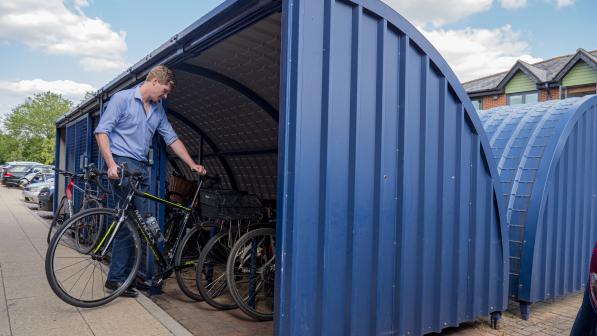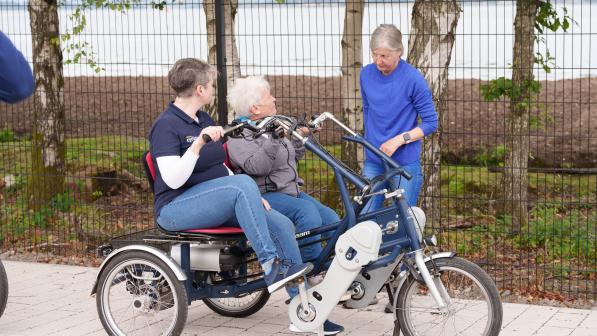A guide to cycle storage options with the Cycle Access Fund

What is the Cycle parking and storage strand?
The Cycle parking and storage strand of the Cycle Access Fund is designed to support the purchase and installation of secure bike storage and parking facilities. This includes:
- Cycle storage: covered facilities like lockers, sheds and shelters where bikes can be locked securely.
- Cycle parking: standalone options such as Sheffield stands and bike racks.
- Cycle storage enhancements: improvements to existing storage, such as installing hooks, shelves or racks.
These facilities help organisations create a safer, more welcoming environment for people travelling by bike – whether that’s staff, residents, students or visitors.
Things to consider before applying
Please get in touch with the supplier and/or a local contractor while you are still in the planning stages of your project. They will be able to give you specifics around groundworks and installation, so you will have a clear picture of any foundation preparation required, costs and timeframe before you make your application.
When planning your bike storage project, consider the following:
- Capacity: how many bikes – and what types or sizes – need to be stored?
- Budget: does your solution fit within the Cycle Access Fund’s parameters?
- Weatherproofing: how important is protection from rain, wind or snow?
- Accessibility: is your storage inclusive for users with varying needs and different cycle types?
- E-bike use: will you need power for charging?
- Visibility and location: is the site easy to access and well lit?
- Permissions and planning: do you need landowner permission or planning approval?
- Groundwork: is there suitable hardstanding for installation?
- Installation: will it be installed by a supplier or by your team?
- Insurance: have you factored in insurance for the facility and its contents?
- Durability and future-proofing: will it last – and is there space to expand?
- Access management: how will you control access if it’s a locked facility?
The costs in your application must be as accurate as possible, so consider all the different factors involved with installing cycle parking or storage. We cannot fund contingency costs and we cannot guarantee extra funding should you find you don't have enough. You can always reach out to the Cycle Access Fund team if you are unsure.

Common storage and parking options
On-street storage
- Good multiple storage fitting within a car parking space
- Works well for on the street parking
- May not be suitable for non-standard cycles or wider cargo bikes
- Open to the elements, especially for e-bikes
- Open to multiple users
- Expensive
- Need permission to use the land it sits on
Shipping containers
- Common use storage for bikes and bike projects
- Lots of room for many different types of bikes including non-standard and cargo bikes
- Might need planning permission
- Not that ‘attractive’
- Reasonable cost for amount of storage
- Variations between single use and new containers
- Check for water tightness and good flooring
- Consider complications with moving and removing container
Bike sheds
- Growing interest in this style of storage
- Official police-approved models available
- More options for storage, racks, hangers and configuration
- Larger models have lots of room for many different types of bikes including non-standard and cargo bikes
- Some models are modular which can be expanded for more room
- Can be self-install or installed by company – check insurance coverage implications for self-install as opposed to professionally installed
- Need level tarmac or paving stones for security anchoring
- Reasonably priced
Cycle lockers/pods
- Can be used as standalone units or banks for multiple lockers
- Good for individualised space and residential areas
- Some models offer solar panels for e-bikes
- May not be suitable for non-standard cycles and wider cargo bikes
- Expensive for limited space
Cycle shelters
- Covered storage for multiple bikes
- Moderate weather protection and theft deterrence
- Requires a fair amount of space
- Works best in well-lit areas with clear sightlines
Sheffield stands
- Widely used and highly versatile
- Suitable for most standard bikes
- Requires solid base (concrete or tarmac) and secure installation
- Suppliers should provide clear installation specifications
Toast racks
- Series of Sheffield-style racks joined together
- Good for high-capacity parking
- Installation and base requirements similar to Sheffield stands

Official guidance on security
When choosing a supplier, check if the products are recognised by Secured By Design, the official police security initiative. The directory includes tested and approved cycle security products.
Find accredited suppliers on the Secured By Design website.
If you’re applying for funding under this strand of the Cycle Access Fund, investing in the right storage solution can make all the difference in supporting long-term, confident cycle use.


